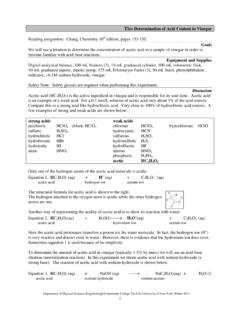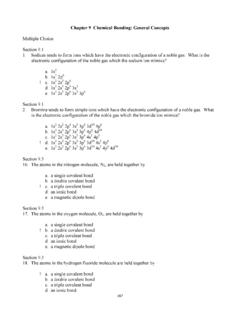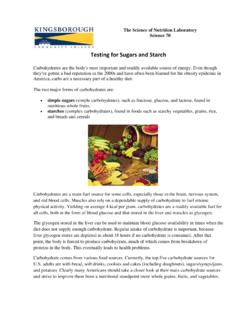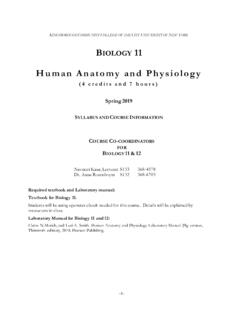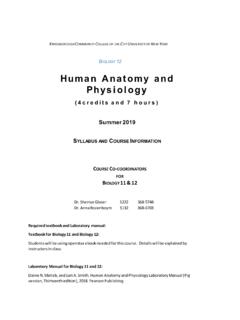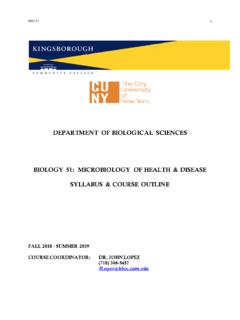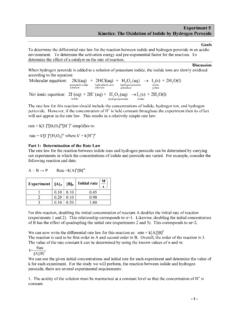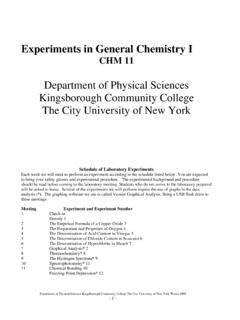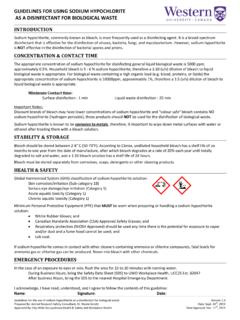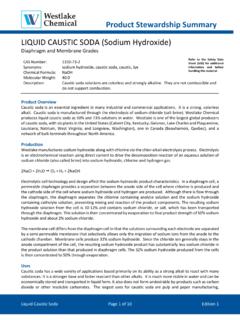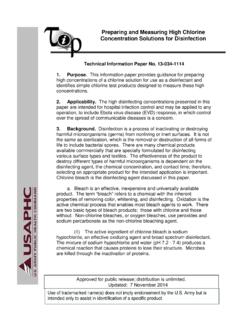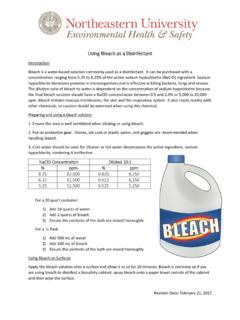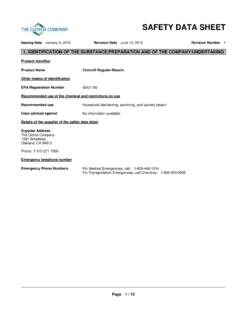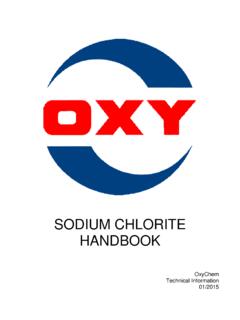Transcription of The Determination of Hypochlorite in Bleach
1 Department of Physical Sciences Kingsborough Community College The City University of New York 2018 1 The Determination of Hypochlorite in Bleach Reading assignment: Burdge, Chemistry 4th edition, section Goals We will study an example of a redox titration in order to determine the concentration of sodium Hypochlorite , the active ingredient in commercial Bleach . Safety Note: Safety glasses and laboratory coats are required when performing this experiment Equipment and Materials buret, 250-mL volumetric flask, volumetric pipette, pipette pump, 200-mL or 300-mL Erlenmeyer flask, 10-mL graduated cylinder, 100-mL graduated cylinder, 100-mL beaker, commercial Bleach solution (4-6% Hypochlorite ), 10% potassium iodide solution (KI), hydrochloric acid solution (HCl), ~ M sodium thiosulfate solution (Na2S2O3), starch solution.
2 Discussion An aqueous solution of sodium Hypochlorite (NaOCl) is a slightly yellow liquid , and is commonly known as Bleach . Aside from its uses as a bleaching agent, sodium Hypochlorite solutions are also used as sterilizing agents and in water treatment. Industrial uses include agriculture, food, paper production, and textiles. sodium Hypochlorite is also added to waste water to reduce odors. The concentration of sodium Hypochlorite in Bleach solutions can be determined by titration. A desirable method would be to find a titrant that reacts with NaOCl to form a colored product. But there are no simple colorimetric titrant-indicator systems that work well.
3 Therefore, we must use a multi-step method to titrate sodium Hypochlorite . In the first step sodium Hypochlorite , hydrochloric acid, iodide ion, and starch are combined to form a starch triiodide complex. In this step there are three reactions that take place: (1) Hydrochloric acid reacts with sodium Hypochlorite to form hypochlorous acid: hypochlorous acidNaOCl (aq) + HCl (aq)HOCl (aq) + NaCl (aq) (2) Hypochlorous acid reacts with iodide when the solution is acidic: ---32triiodideHOCl (aq) + HCl (aq) + 3I (aq)I (aq) + 2Cl (aq) + H O (l) Tridiodide, I3 , is a dark red complex. A dark blue complex is formed when triiodide is combined with starch.
4 (3) --33triiodidetriiodide starchioncomplex (dark blue)I + starch[I ][starch] The result of these three reactions is that when sodium Hypochlorite is present the starch-triiodide complex is produced. This is useful because the result of these three reactions is the formation of a dark blue complex that has a concentration that is proportional to the amount of sodium Hypochlorite in the solution. In the next step, the starch-triiodide product is titrated by sodium thiosulfate to form a colorless solution of iodide, dithionate, and uncomplexed starch: (4) -2--2-32346iodide iontriiodide starchthiosulfatedithionatecolorlesscomp lex (dark blue)[I ][starch] + 2S O3I + S O + starch 2 If iodide is added in excess to the hypochlorous acid then all of the hypochlorous acid will be reacted, forming the dark blue starch-triiodide complex.
5 The Hypochlorite acts as a limiting reagent, determining how much triiodide is produced. We can then titrate the triiodide-starch complex with the thiosulfate to determine the concentration of the complex formed. This can then be used to calculate the initial concentration of Hypochlorite . Procedure SAFETY PRECAUTIONS Safety glasses or goggles must be worn throughout this experiment. Bleach is a strong oxidizing agent and should be washed from skin. Bleach can also damage clothing. For that reason, take care not to splash any of the Bleach solution on clothing. 300 mL Erlenmeyer 50 mL 25 mL beaker 250 mL volumetric Flask buret volumetric pipet flask 1.
6 Students perform titrations individually. Dilution of the Bleach (Step 3 below) can be performed in pairs. 2. Obtain about 60 mL of sodium thiosulfate solution using a clean and dry 100-mL beaker. Record the concentration of this solution on the Data Sheet. Rinse a 50-mL buret with tap water and then distilled or deionized water. Rinse the buret with a few milliliters of the sodium thiosulfate solution. Fill the buret to just above the 0 mL mark with sodium thiosulfate solution. Allow a few milliliters to pour through the buret tip so that any trapped air can be flushed through. Read and record the initial buret level to the nearest mL.
7 3. Perform a 10-fold quantitative dilution of Bleach . This step can be performed with a partner and the diluted Bleach shared. Use a clean 25-mL volumetric pipet to deliver mL of Bleach solution into a clean 250-mL volumetric flask. Add distilled or deionized water to the mark of the volumetric flask. Be sure to mix the solution well to ensure that it is homogeneous. The Bleach should now be one-tenth its original concentration and can be used in your titrations. Rinse the pipet with distilled or deionized water to remove the Bleach solution. 4. The titration takes place in a large Erlenmeyer flask.
8 Using the 25-mL volumetric pipet, carefully add mL of diluted Bleach (from Step 3) to the Erlenmeyer flask. 5. Using a 100-mL graduated cylinder, add about 15 mL of distilled or deionized water to the reaction flask. Department of Physical Sciences Kingsborough Community College The City University of New York 2018 3 6. Using a 100-mL graduated cylinder, add about 20 mL of 10% potassium iodide solution to the reaction flask. 7. Pour about 2 mL of starch solution in a 10-mL graduated cylinder. This starch solution will be added to the Erlenmeyer flask later. 8. Using a 100-mL graduated cylinder, add about 20 mL of hydrochloric acid solution to the reaction flask.
9 Begin the titration promptly after adding this solution to the mixture. 9. Begin titrating the Bleach solution with sodium thiosulfate solution. Add the thiosulfate solution to the Erlenmeyer flask while swirling until the solution in the flask becomes a pale yellow color. Be sure not to add so much that the solution becomes clear. You are looking for a pale yellow color. Once the solution turns pale yellow get the starch solution ready. Don t write down the volume on the burette at this point; you ll be adding more thiosulfate solution in a few moments. There may be a dark precipitate of crystals of solid iodine if you are slow in getting to this stage.
10 10. Add the 2 mL of starch solution from the graduated cylinder to the Erlenmeyer flask. The color of the solution should now be dark blue. 11. Continue the titration dropwise (this means one drop at a time, slowly) with constant swirling until the solution becomes clear. This clear solution signals the endpoint of the titration. Record the buret volume level in the data sheet to the nearest mL. The contents of the Erlenmeyer flask should be poured into the proper waste container. 12. Perform two more titrations by repeating steps 3-11. You may need to use the same Erlenmeyer flask. 13. The density of the Bleach solution should be measured or given to you by the instructor.
